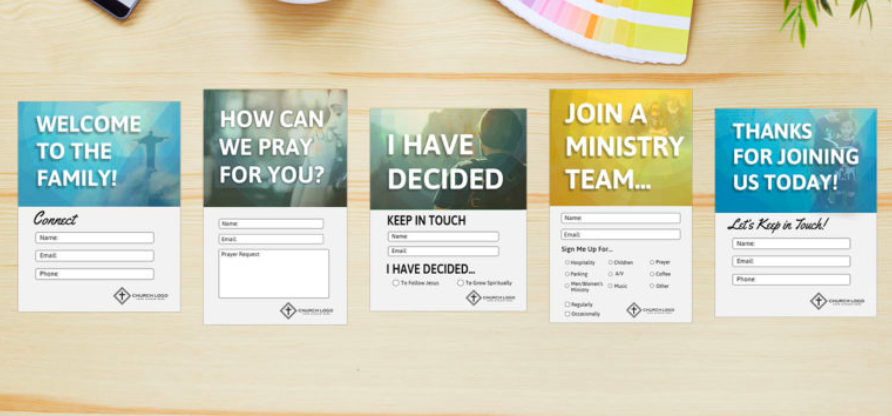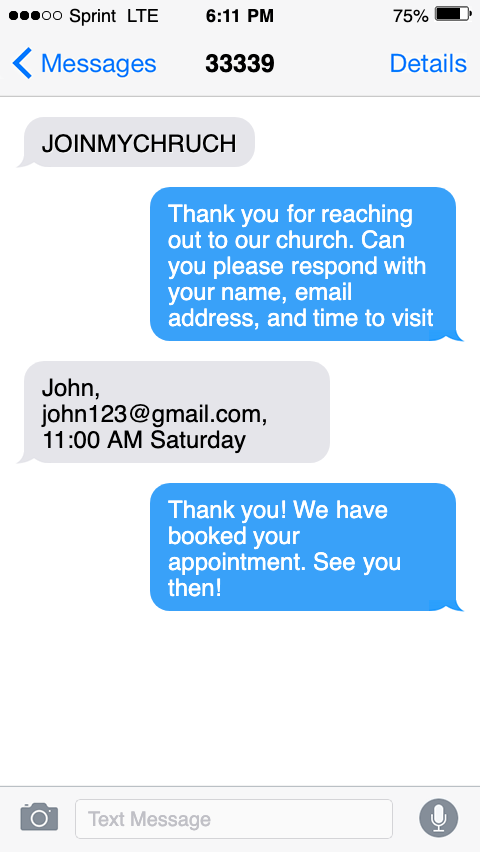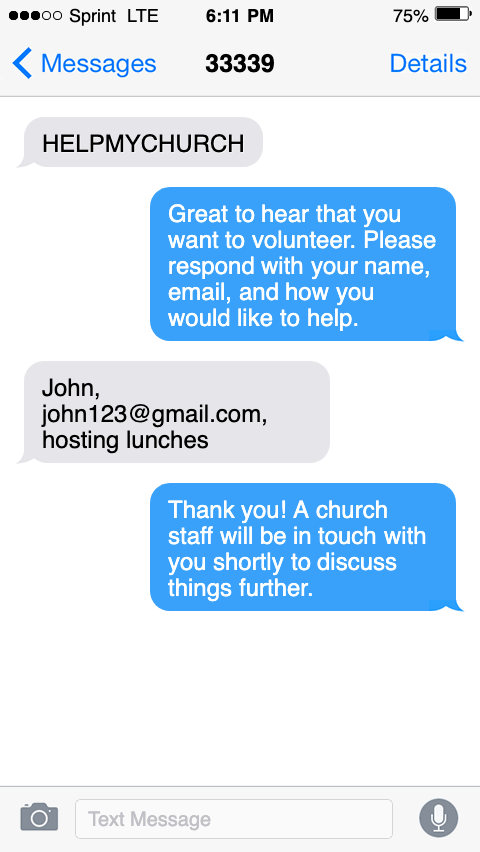Table of Contents
Every sound church visitor follow-up strategy involves the visitor taking the first step in connecting to the church.
A church communication card plays a crucial role here. It helps visitors identify themselves to the church and announce that they are looking for ‘more’ than just visiting every time.
“As soon as people raise their hands to say, “I am here,” they’ve moved a step closer to the community. They go from being part of the invisible mass to signaling that they would like to make a deeper connection.” – Rich Birch, Unseminary.
However, if a church communication card is not designed right or not introduced at the right time, the church misses the opportunity to connect with the visitor and engage them further.
In this post, we will aim to understand the church communication card a little bit better so that you can better use it for your church.
What is a church communication card?
A church connection card (also called a communication card) is a physical card that is handed out by churches to encourage its members to respond. It is one of the few ways a church member/visitor can initiate a conversation with the church.

Examples of church connection cards from churchtechtoday.
The communication cards are kept at strategic places in the church, where a visitor is most likely to frequent. E.g.
- the welcome kiosk
- the visitor’s corner or
- even at the volunteer recruitment desk
All the visitor has to do is fill it up and hand it back at the desk. A church member will then use the details specified and reach out to them.
Importance of church connection cards
A church connection card is key in bringing the visitor closer to the congregation. While that is the biggest motivation for churches to use a connection card, here are a few ways it can help.
- Collecting contact info
- Encouraging new members to sign up and boost membership
- Getting families through the door;
- Generating engagement within the congregation (e.g., connection cards specific for volunteering)
- Keeping congregation up to date with church information
Ultimately, having a connection card will mean a more effective church visitor follow-up strategy for your congregation.
Challenges to using church connection cards
Notice that the success of a church connection card hinges on one single aspect – of the visitor successfully filling it out.
If there is any friction in this step that distracts the visitor from actually completing the form, then the connection cards will not be as useful.
In general, there are 3 challenges that hinder the completion of a church connection card:
a) Poor design
Poor color coordination, a template that is not easy to read, and a cluttered form make it tough for the visitor to fill all the fields.
b) Too many fields to fill
Having multiple form fields is a high deterrent to successful completion. A study by Barna shows that millennials (especially) are very reticent when it comes to handing out personal information. So when faced with the prospect of filling in a name, phone number, contact address, and email id, the chances of the visitor completing all the fields are quite less.
Instead, you can only ask for the bare minimum information (e.g., name & email id (or) contact number) and then ask for more information in later touchpoints.
c) Sticking only to paper communication cards
In a mobile-first era, filling out a paper form can be slightly difficult for members (especially Gen Zs and millennials). This does not mean that you do away with all paper copies of the connection cards.
It simply means that you have an alternative – a digital option for those members who prefer it.
As a rule of thumb, paying attention to the above details and rectifying it can decrease the number of drop-offs to connection card completion.
How to create a successful church communication card?
Knowing what not to do (like having too many fields, etc.) can still mean that there are numerous ways you can fail at creating the perfect church communication card.
So here are certain best practices (or tips) that can help you out.
1. Use different cards for different purposes (color code to keep track)
For instance, first-time visitors who are looking to know more about your congregation can fill out a ‘yellow’ card at the kiosk. Members who are looking to volunteer, however, can fill out the ‘green’ card.
Segregating the cards by color and using different cards for different purposes reduces confusion among the members.
It also makes it easy for you (and your church management software) to keep a better track of member behavior. E.g., you can note down in your CRM saying (filled out a volunteer connection card). Later, you can filter out only those members who have shown interest in volunteering and invite them to a volunteer recruitment meeting.
Such targeted messaging might not be possible if the segmentation wasn’t done at the source (i.e., while filling out the connection card).
2. Keep fields to a minimum (the fields will depend upon the purpose of the card)
There is no need for an existing member to give their physical contact address – in all possibility, you would already have it.
Similarly, a first-time visitor does not have to specify what kind of volunteering would appeal to them.
Instead, each card can have specific form fields based on the target audience. That means a first-time visitor can fill out only their name and email address. While for a member looking to volunteer, an additional field of ‘how they would like to help’ can be added.
3. Always have an opt-in box for text message updates
Using a church connection card to build communication across other channels is an excellent way to add more impact to your visitor communication strategy. This way, you can send text message updates to the visitor (instead of merely relying on phone calls or emails).
Learn how to set up text opt-in campaigns in minutes.
4. Pay attention to the language (good copy, no slang/jargon, make it funny)
Remember that the connection card is an opportunity to engage with your visitor/member. So it is important to keep your copy compelling and the language straightforward.
If you think your audience would appreciate humor, then go ahead and test that too (maybe in a volunteer sign-up card), and see how it works for you.
5. Go digital with your connection cards (have a tablet at the kiosk)
Having a digital connection card means having autofill options (for existing members). This makes it easier for them to fill out the form and thus improves form completions.
A digital form also means that it is easier for you to collect the data and store it in your CRM (instead of copying it from a card).
Keep in mind that your church members are different and that your church’s communication strategy is unique.
What this means is that there is no perfect church connection card that you can automatically replicate. While the numerous church connection card templates can act as a starting point, it is up to you to keep testing and improving on the cards.
Using text messages as connection cards
Text messages have an unparalleled advantage over traditional connection cards. Text messages are:
- Easy to respond to
- Non-intrusive – so the reader can text back at their convenience
- Appeal to a larger audience
- And are more widely read (95% of texts are read within the first 3 minutes)
In general, church texting service is used to bring the congregation closer. Here is a snapshot of how text messages can be used to help your church
| S.No. | How can it help? | What texting options do you have? |
| 1. | Keep the congregation more engaged | Peer-to-peer texts, bulk texts |
| 2. | Using texts for volunteer recruitment | Opt-in text messages peer-to-peer text messages for follow up |
| 3. | Gathering visitor information | Opt-in text messages |
| 4. | Increase attendance | Reminders and notifications using bulk texts |
| 5. | Tithe collection & fundraising | Text-to-give, Text-to-donate, personal conversations via peer-to-peer texts |
However, you can also successfully use text messages as an alternative to church connection cards.
All members have to do is send a keyword (FAITH) to your shortcode (e.g., 33339) to trigger a series of automated text messages that can:
- Collect information about the member
- Offer targeted information that the member is looking for
- Direct the member to other sources (e.g., website/your office) for more details.
As with any digital channel of communication, this interaction can automatically be added to your CRM (based on the church communication software that you use).
Collecting contact info about a new lead
Step 1. Promote a keyword and shortcode on the website or across the neighborhood. E.g., Send JOINMYCHURCH to 33339 to set up an appointment with our church.
You can also ask the members of your congregation to spread the word (word of mouth). The shortcode 33339 can either be a shared shortcode, or one that is exclusively used by your church.
Step 2. Direct your church communication software to handle responses automatically. Here is how the conversation can go:

Step 3. Connect to your CRM. Ensure that your church texting service syncs with your CRM. This will automatically add the visitor and their details as a new lead.
Step 4. Close the loop – keep your church staff updated about the appointment.
Volunteer recruitment using text messages
Step 1. Promote keyword and shortcode (it can be on your website, on message boards, via an announcement from the pulpit, or even on flyers and notice boards). Remember that the keyword you use should be different from what you have used previously.
Rather than having different colored church communication cards for different purposes, you should have different keywords for each initiative.
The shortcode, however, remains the same.
Step 2. Set up to handle automatic responses in your church communication software. Here is how the conversation can go:

Step 3. Connect to your CRM – mention how the member wants to be involved.
Step 4. Close the loop – Ensure that your church staff reaches out to the member.
Remember that using text to join (or SMS opt-ins) like church communication cards are very similar. All you can do is:
- Collect information,
- Ask for the least amount of information from the lead
- Contact them later using the information they have provided.
Once you have collected the basic information, you can engage with the member via peer-to-peer text messages and encourage them to take the next step (e.g., become a member or come for a volunteer meeting).
Keep in mind that in both the above use cases, it is important that the church staff do not ask for the same information one more time.
E.g., Once a visitor has planned a visit via text, they shouldn’t have to fill out a connection card asking for the same details they have already provided.
Though it may seem like a trivial detail, it goes a long way in providing a great experience to your church visitors -and it is that which ultimately makes them stay!
Featured image credits:Andrea Piacquadio

